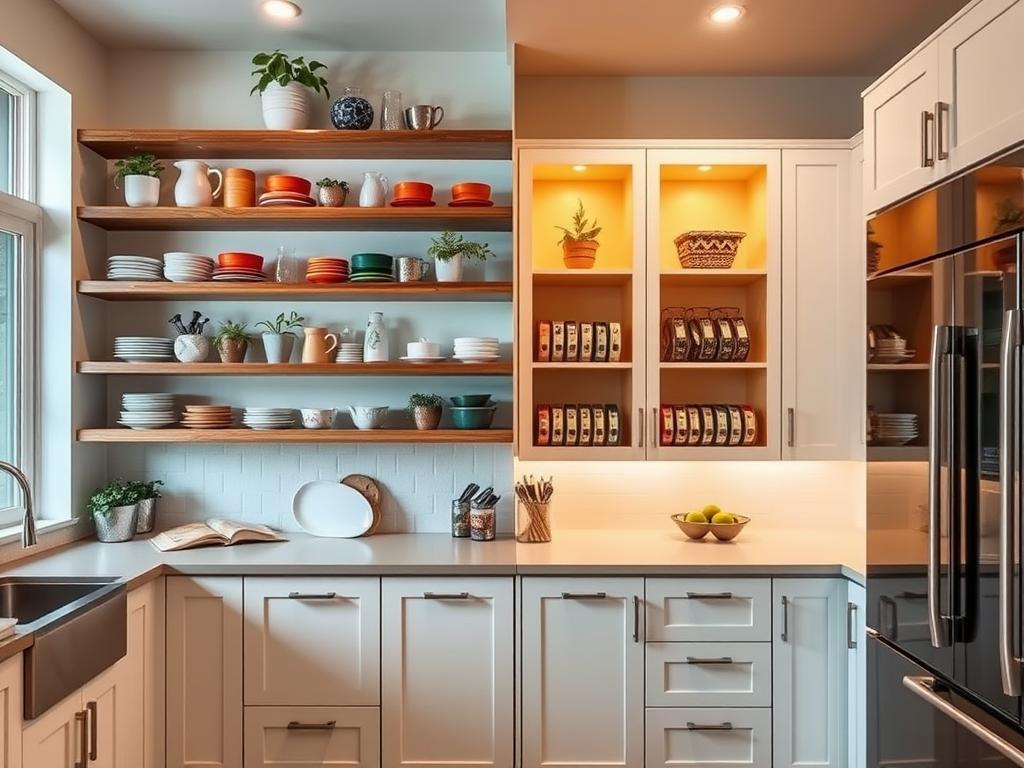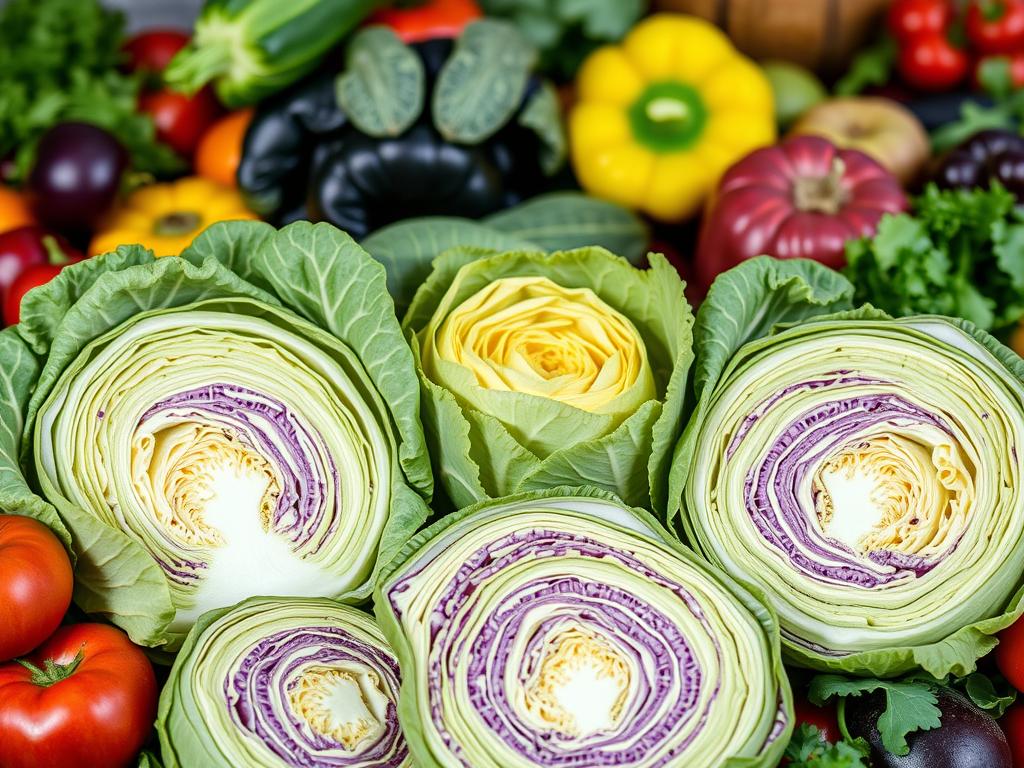Open Shelving in Kitchen: Imagine stepping into your dream kitchen, greeted by a delightful display of colorful dishware and thoughtfully arranged utensils inviting you to create your next meal. Open shelving has become a prevalent trend in modern homes, merging style with practicality in captivating ways. While the appeal of showcasing beautiful kitchen items is undeniable, the decision to embrace open shelving isn’t as straightforward as it seems.
As timeless designs evolve and personal tastes shift, the pros and cons of open shelving in the kitchen invite contemplation. This guide is here to help you navigate the world of open shelves, examining the benefits they offer alongside the challenges they may present. Whether you’re seeking fresh kitchen storage solutions or simply drawn to the aesthetic allure of open shelving, this journey will illuminate the choices available to you.
Key Takeaways
- Open shelving adds a unique aesthetic to kitchen design while providing visibility for display items.
- Accessibility and convenience are significant open shelving benefits, making cooking and meal prep smoother.
- Regular maintenance is essential to combat dust accumulation on open shelves.
- The choice between open shelving and closed cabinets often reflects personal taste and the desired kitchen ambiance.
- Open shelving allows for creative styling, enhancing the kitchen’s visual appeal through ever-changing arrangements.
- Adopting open shelves can be a cost-effective way to refresh kitchen spaces compared to traditional cabinetry.
What is Open Shelving in Kitchen?
Open shelving in the kitchen represents a revolutionary approach in storage design, characterized by the absence of cabinet doors. This layout promotes an airy and uncluttered environment, allowing homeowners to display their kitchen essentials while enhancing accessibility. The definition of open shelving encapsulates more than just storage; it embodies a modern kitchen design trend that balances functionality with aesthetics.
Definition and Overview
The open shelving definition emphasizes the concept of showcasing items like dishware, cookbooks, and decorative plants. This format enables creative expression, enabling the combination of various materials such as raw wood and stainless steel to add visual interest. As one of the most prominent trends in kitchen design, open shelving transforms spaces by making them feel larger and more inviting, particularly in compact or dimly lit areas.
Popularity in Modern Design
Post-pandemic lifestyles have shifted cooking habits, elevating the demand for storage solutions that are both accessible and visually appealing. Open shelving allows for personalization in the kitchen, providing a canvas for individuals to display their favorite items. While some may worry about the visibility of stored goods, this trend fosters a unique opportunity to curate matching dish sets and decorative pieces. Platforms like Pinterest frequently spotlight open shelving, highlighting its place within modern kitchen design trends.
Advantages of Open Shelving
Open shelving has emerged as a popular choice for kitchen design, offering numerous advantages that enhance both style and functionality. The benefits of open shelving extend beyond mere aesthetics, making it a favored option among homeowners aiming for a modern and inviting kitchen space.
Enhanced Aesthetics and Style
The style advantages of open shelving are significant, as it allows for the creation of visually stunning displays using attractive dishware, plants, and decorative items. This method of storage contributes to an aesthetic appeal that can elevate the overall design of any kitchen. Open shelving complements various interior styles, such as industrial, minimalist, farmhouse, and contemporary designs, making it a versatile choice that enhances the visual character of the space.
Accessibility and Convenience
One of the key kitchen organization benefits of open shelving is the enhanced accessibility it provides. Items are readily available, making it easier to grab what you need while cooking. This convenience boosts the overall cooking experience, allowing tasks to be performed more efficiently without the hassle of opening and closing cabinet doors. The open concept fosters a sense of openness, particularly beneficial in smaller kitchens.
Encourages Organization and Minimalism
Open shelves promote a minimalist approach to kitchen organization, encouraging individuals to declutter and showcase only the most essential and beautiful items. This commitment to organization often results in a tidier and more visually appealing environment. By combining personal collections and decorative pieces, open shelving allows homeowners to infuse their personality into the space while ensuring that everything remains orderly. A properly styled open shelf can be both functional and a statement piece in the kitchen.
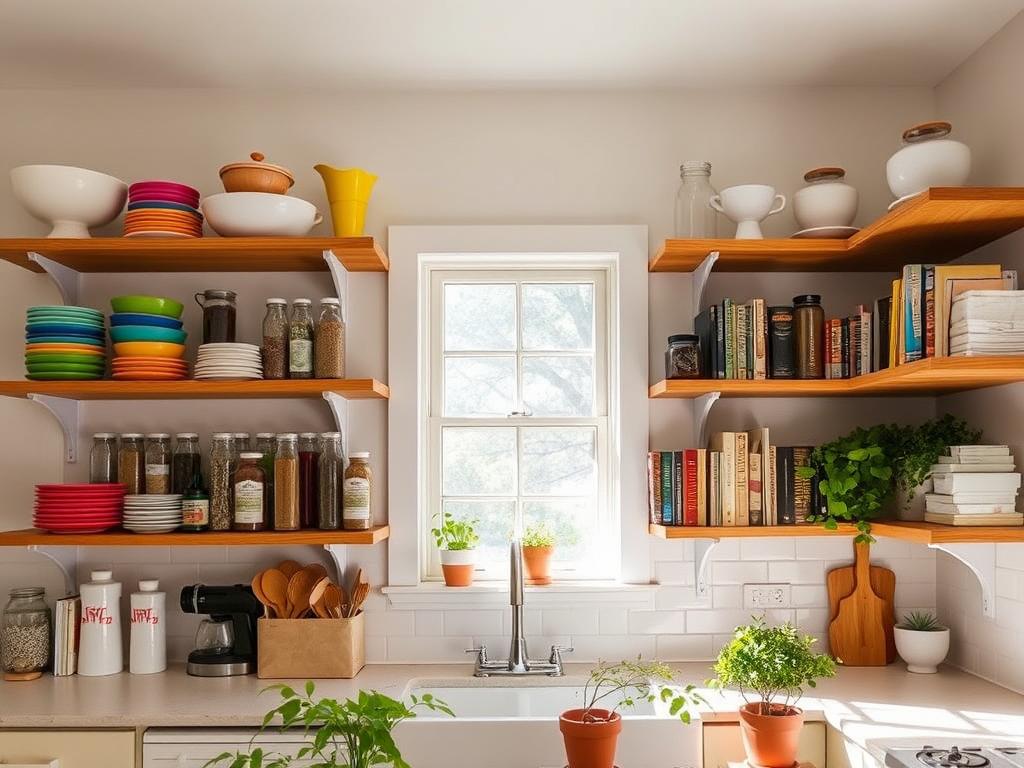
For those considering open shelving, it is essential to weigh these advantages against the potential drawbacks in order to make an informed decision. To explore these aspects further, visit this resource.
Disadvantages of Open Shelving
While open shelving continues to gain popularity in modern kitchens, it is crucial to consider the disadvantages this storage solution presents. Open shelves can enhance aesthetic appeal, yet they often come with practical challenges that may discourage their adoption.
Dust and Maintenance Challenges
One of the primary cons of open shelving involves open shelving maintenance challenges. Items on these shelves tend to accumulate dust and grease, particularly if situated near cooking appliances. Frequent cleaning becomes essential to maintain the shelves’ visual appeal, making it a less convenient option for busy homeowners.
Limited Storage Capacity
Open shelving naturally limits storage capacity compared to traditional cabinets. It struggles to accommodate larger or bulkier items, often necessitating thoughtful selection regarding what to display. This limitation may lead to clutter over time, detracting from the organized look intended by choosing open shelving. As a result, this setup may misalign with some users’ storage needs.
Impact on Privacy and Clutter
Privacy concerns with open shelving should not be overlooked. The constant visibility of kitchen items may overwhelm some homeowners, contributing to a feeling of disorder, especially during meal prep. Additionally, the lack of concealment may foster a less personal space, which might not appeal to everyone’s sense of privacy and comfort.
Finding a balance between aesthetics and functionality is vital for a well-designed kitchen. Exploring options such as decorative French dressers or glass-front cabinets may help alleviate some of the downsides of open shelving while maintaining an attractive look. Adapting one’s approach to kitchen design and can enhance both practicality and style.
| Disadvantage | Description |
|---|---|
| Dust & Maintenance | Items collect dust and grease, necessitating frequent cleaning. |
| Storage Capacity | Limited ability to store bulky items, leading to potential clutter. |
| Privacy Concerns | Constant visibility of items may overwhelm, impacting the sense of privacy. |
Material Options for Open Shelving
Selecting the appropriate materials for open shelving plays a crucial role in a kitchen’s functionality and overall aesthetic. The popular choices include wood and metal, each offering distinct styles and durability. Understanding the differences can help homeowners make informed decisions about enhancing their spaces.
Wood vs. Metal: A Comparison
When comparing wooden vs. metal shelving, various factors come into play. Wooden shelves provide warmth and a rustic charm, making them ideal for traditional or country-style kitchens. Options range from raw wood to finished varieties, catering to different tastes. Metal shelves, on the other hand, add an industrial flair and are often more suited for contemporary or minimalist designs. They can withstand significant weight, which might be beneficial for heavier kitchen items.
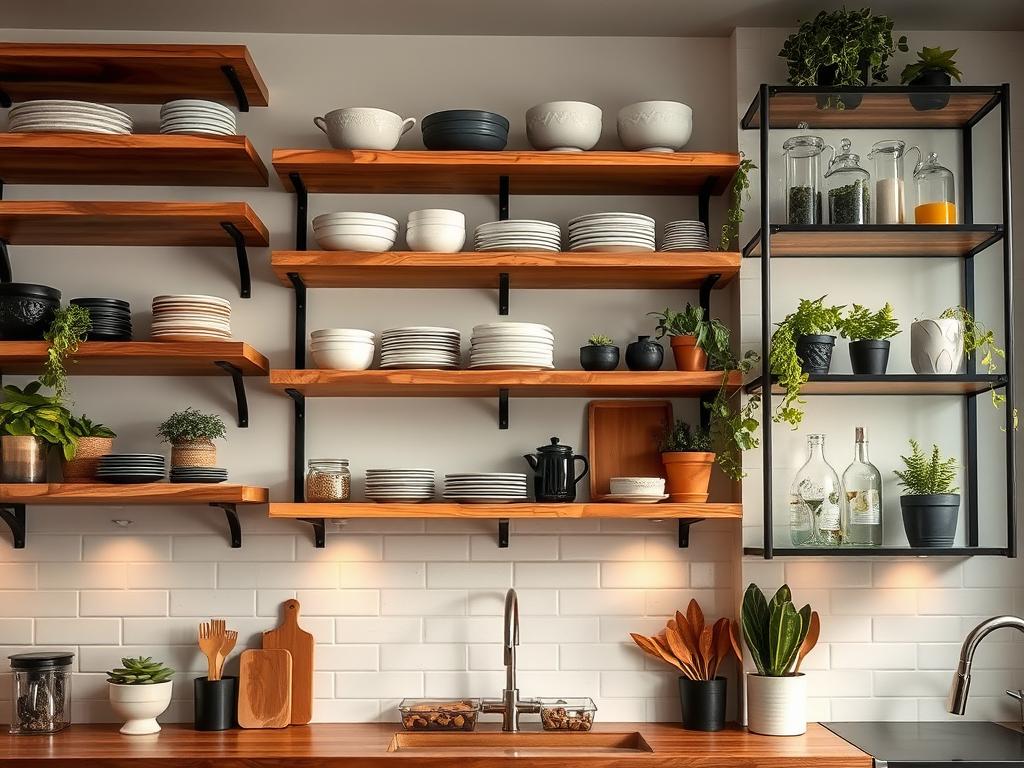
Shelving Styles: Floating vs. Traditional
Floating shelves vs. traditional shelving represent two distinct styles that serve different purposes. Floating shelves offer a sleek, modern look, expanding visual space in the kitchen. Their installation allows for customization in height and spacing, making them adaptable to various layouts. Traditional shelving, supported by brackets, provides a sturdy option that can hold heavier items more securely. Both styles have their advantages, and the choice often hinges on personal taste and the kitchen’s design theme.
For a deeper understanding of the advantages and challenges associated with open shelving, explore the pros and cons of kitchen storage. This knowledge aids in selecting suitable open shelving materials and styles that best match individual needs and preferences.
Best Practices for Styling Open Shelving
Styling open shelving can transform a kitchen into a visually captivating space. The first step involves careful selection of items to showcase items on shelves that reflect personal taste and functionality. A cohesive color palette helps in creating visual harmony, while highlighting distinctive collections or unique pieces makes a bold statement.
Selecting Items to Showcase
Choosing the right items is essential for successful styling. Functional items such as everyday dishware, cooking essentials, and striking fruit bowls can easily serve a dual purpose. Containers and canisters offer hidden storage solutions while still adding style. Incorporating elements like stylish kitchen accessories allows for both organization and decor.
Creative Arrangement Ideas
Implementing open shelving arrangement ideas can enhance the overall aesthetic. Varying the heights and orientations of items creates interest and prevents monotony. Symmetrical layouts can provide a clean and organized appearance, especially in modern farmhouse or Scandinavian kitchens. Adding greenery, such as plants or fresh flowers, brings life and freshness to the space. This blend of functional and stylish choices ultimately transforms open shelves from mere storage spaces into focal points within the kitchen.
Cleaning and Maintenance Tips
Maintaining open shelves can be both easy and efficient with the right strategies. Regular upkeep is vital, especially in a kitchen environment where grime and dust can accumulate quickly. Embracing effective open shelving cleaning tips not only helps maintain the aesthetic appeal but also ensures your dishes and utensils remain clean and safe to use.
How to Keep Open Shelves Dust-Free
Dust-free shelves can enhance the overall look of your kitchen. Regular dusting prevents build-up, especially on lower open shelves, which tend to collect dust more readily. Using microfiber cloths is an excellent approach, as they trap dust effectively. Keeping frequently used items at eye level also encourages tidiness, making it easier to maintain clean surfaces.
Best Cleaning Supplies to Use
The right cleaning supplies for shelves make all the difference. Gentle all-purpose cleaners work well for most materials without causing damage. For a natural approach, consider using vinegar or baking soda, particularly useful for greasy areas. Clear storage bins not only organize your items but also minimize clutter, facilitating simpler cleaning and maintenance routines. A deep clean should occur about once a month or based on usage to keep those open shelves looking pristine. Explore more tips on creating a welcoming environment for all your home’s inhabitants at this guide.
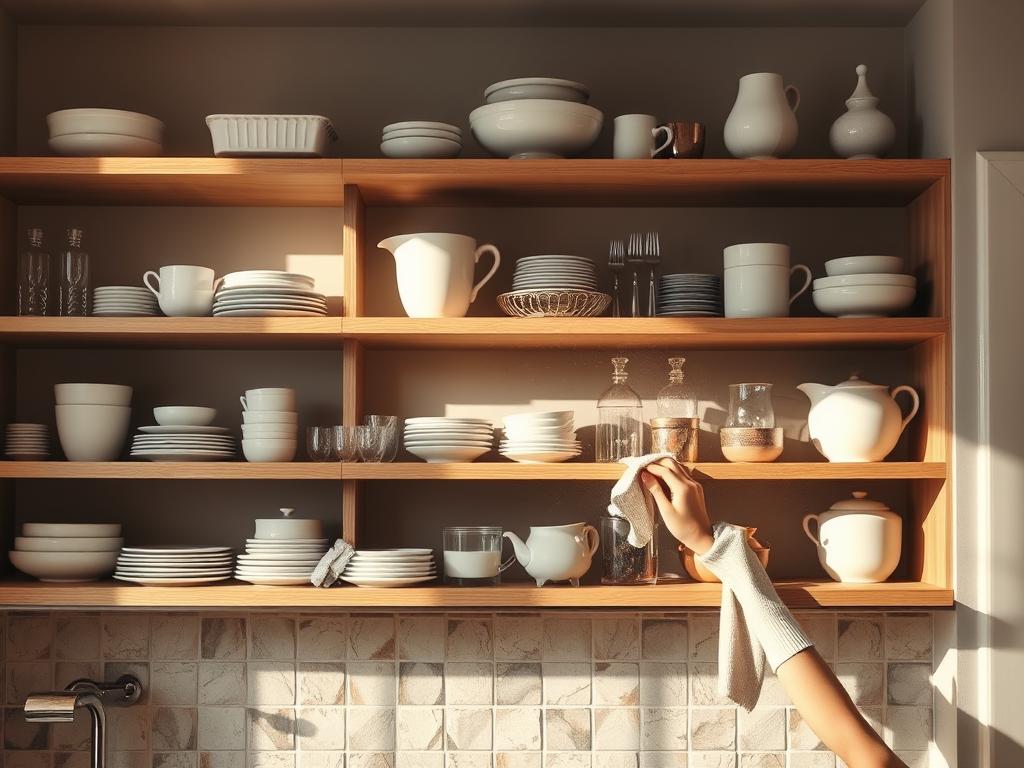
Open Shelving vs. Closed Cabinets: A Comparison
When evaluating kitchen storage solutions, comparing open shelving vs. cabinets reveals significant differences in terms of space efficiency and cost. Each option brings its unique advantages and disadvantages, essential for tailoring to individual needs and preferences. Understanding how these two systems stack up will aid in making a well-informed choice.
Space Considerations
Open shelving creates an illusion of space, making smaller kitchens appear larger. This design element invites light and accessibility, allowing attractive dishes and glassware to serve as decor. While open shelving encourages organization and showcases kitchen aesthetics, closed cabinets excel in providing secure, hidden storage. Homeowners often wrestle with the limitations of open shelving, which may not accommodate all kitchen necessities, while closed cabinets offer versatility with more efficient storage options.
Costs and Budgeting
A cost comparison open shelving shows that open shelves typically come with a lower price tag than traditional cabinets. The modular cabinetry introduced in the 1920s has become more expensive due to the materials involved, such as doors and hardware. Homeowners can find relief in selecting wall shelves, as these often require less investment and upkeep. Nevertheless, achieving a balance between aesthetics and function might lead some to incorporate both styles, optimizing design and practicality while managing costs.
Real-Life Examples of Open Shelving
Open shelving has become a significant trend in kitchen design, reflecting the growing preference for functionality paired with aesthetic appeal. In various inspirational kitchens around the country, homeowners have adopted this style, showcasing their personal tastes while maximizing space efficiency. These examples highlight the versatility of open shelving, demonstrating how it can make a kitchen feel open and airy while serving practical purposes.
Inspirational Kitchens with Open Shelving
Many kitchens now blend creativity with practicality by installing open shelving alongside closed cabinets. This approach provides the best of both worlds: a visually pleasing display of dishes and décor, while still offering concealed storage for kitchen essentials. Homeowners have shared their experiences, noting a cost-effective transformation where a modest budget of $325 was allocated for open shelves that complemented existing cabinetry. These open shelving examples often emphasize DIY efforts that bring personal touches to the overall design, fostering an inviting atmosphere in the kitchen.
User Experiences and Testimonials
Personal experiences with open shelving reveal a mix of satisfaction and challenges. For some, the joy of easy access to favorite dishes outweighs the extra 30 seconds spent dusting. As one homeowner remarked, the initial doubts about installation quickly faded once they realized the transformation it brought to their space. While a few commenters from a reader quiz on Apartment Therapy expressed a preference for sewn cabinet doors, others leaned toward the cleaner, modern vibe of open shelving. These kitchen design inspiration stories not only convey the beauty of this trend but also underscore the importance of balancing visual aesthetics with everyday practicality.

